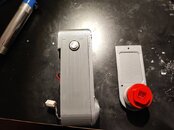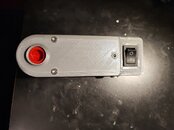HeXx
Contributor
As in another discussion about Undepleatable oxygen sensors I think it would be more appropriate to continue the topic here.
Previous posts on this thread: Thread
So I finally got to order some parts for my first prototype.
A bit different from the initial project but I can start simpler and then work my way up.
The first prototype will be with a simple galvanic cell. on/off switch and cal/extended functionality button.
Micro USB rechargeable battery and user replaceable (LiPo)
In its basic functionality, it will be able to measure PPo2 based in its last calibration parameters and show MOD for 1.4 and 1.6 PPo2.
Entering extended mode, by pressing the button while turning on activates communication with a phone via WiFi (APP).
In extended mode you can do a single step (air) calibration with parameters of temperature, RH, and pressure to account for calibration at altitude.
Will also be possible to do a two point calibration where you can set the second point to calibrate with a known oxygen mixture between 50 and 99.9%.
Lastly, it will be possible to measure presence of CO in the gas under test (minimum 10ppm, value might be lower after testing and tuning)
Ideas and suggestions are welcome.
Cheers
Previous posts on this thread: Thread
So I finally got to order some parts for my first prototype.
A bit different from the initial project but I can start simpler and then work my way up.
The first prototype will be with a simple galvanic cell. on/off switch and cal/extended functionality button.
Micro USB rechargeable battery and user replaceable (LiPo)
In its basic functionality, it will be able to measure PPo2 based in its last calibration parameters and show MOD for 1.4 and 1.6 PPo2.
Entering extended mode, by pressing the button while turning on activates communication with a phone via WiFi (APP).
In extended mode you can do a single step (air) calibration with parameters of temperature, RH, and pressure to account for calibration at altitude.
Will also be possible to do a two point calibration where you can set the second point to calibrate with a known oxygen mixture between 50 and 99.9%.
Lastly, it will be possible to measure presence of CO in the gas under test (minimum 10ppm, value might be lower after testing and tuning)
Ideas and suggestions are welcome.
Cheers






